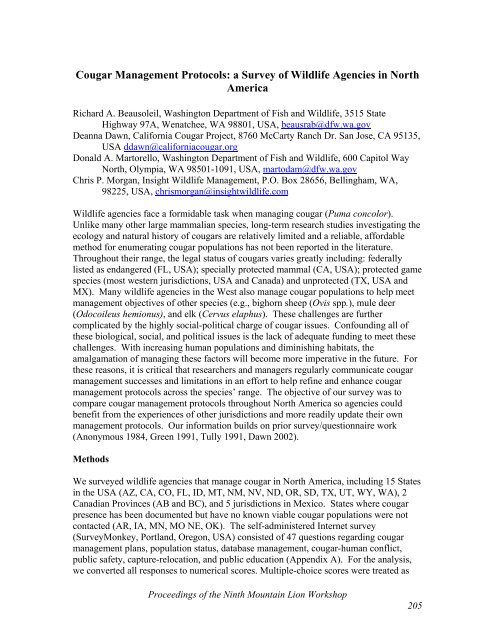Proceedings of the Ninth Mountain Lion Workshop - Carnivore ...
Proceedings of the Ninth Mountain Lion Workshop - Carnivore ...
Proceedings of the Ninth Mountain Lion Workshop - Carnivore ...
You also want an ePaper? Increase the reach of your titles
YUMPU automatically turns print PDFs into web optimized ePapers that Google loves.
Cougar Management Protocols: a Survey <strong>of</strong> Wildlife Agencies in North<br />
America<br />
Richard A. Beausoleil, Washington Department <strong>of</strong> Fish and Wildlife, 3515 State<br />
Highway 97A, Wenatchee, WA 98801, USA, beausrab@dfw.wa.gov<br />
Deanna Dawn, California Cougar Project, 8760 McCarty Ranch Dr. San Jose, CA 95135,<br />
USA ddawn@californiacougar.org<br />
Donald A. Martorello, Washington Department <strong>of</strong> Fish and Wildlife, 600 Capitol Way<br />
North, Olympia, WA 98501-1091, USA, martodam@dfw.wa.gov<br />
Chris P. Morgan, Insight Wildlife Management, P.O. Box 28656, Bellingham, WA,<br />
98225, USA, chrismorgan@insightwildlife.com<br />
Wildlife agencies face a formidable task when managing cougar (Puma concolor).<br />
Unlike many o<strong>the</strong>r large mammalian species, long-term research studies investigating <strong>the</strong><br />
ecology and natural history <strong>of</strong> cougars are relatively limited and a reliable, affordable<br />
method for enumerating cougar populations has not been reported in <strong>the</strong> literature.<br />
Throughout <strong>the</strong>ir range, <strong>the</strong> legal status <strong>of</strong> cougars varies greatly including: federally<br />
listed as endangered (FL, USA); specially protected mammal (CA, USA); protected game<br />
species (most western jurisdictions, USA and Canada) and unprotected (TX, USA and<br />
MX). Many wildlife agencies in <strong>the</strong> West also manage cougar populations to help meet<br />
management objectives <strong>of</strong> o<strong>the</strong>r species (e.g., bighorn sheep (Ovis spp.), mule deer<br />
(Odocoileus hemionus), and elk (Cervus elaphus). These challenges are fur<strong>the</strong>r<br />
complicated by <strong>the</strong> highly social-political charge <strong>of</strong> cougar issues. Confounding all <strong>of</strong><br />
<strong>the</strong>se biological, social, and political issues is <strong>the</strong> lack <strong>of</strong> adequate funding to meet <strong>the</strong>se<br />
challenges. With increasing human populations and diminishing habitats, <strong>the</strong><br />
amalgamation <strong>of</strong> managing <strong>the</strong>se factors will become more imperative in <strong>the</strong> future. For<br />
<strong>the</strong>se reasons, it is critical that researchers and managers regularly communicate cougar<br />
management successes and limitations in an effort to help refine and enhance cougar<br />
management protocols across <strong>the</strong> species’ range. The objective <strong>of</strong> our survey was to<br />
compare cougar management protocols throughout North America so agencies could<br />
benefit from <strong>the</strong> experiences <strong>of</strong> o<strong>the</strong>r jurisdictions and more readily update <strong>the</strong>ir own<br />
management protocols. Our information builds on prior survey/questionnaire work<br />
(Anonymous 1984, Green 1991, Tully 1991, Dawn 2002).<br />
Methods<br />
We surveyed wildlife agencies that manage cougar in North America, including 15 States<br />
in <strong>the</strong> USA (AZ, CA, CO, FL, ID, MT, NM, NV, ND, OR, SD, TX, UT, WY, WA), 2<br />
Canadian Provinces (AB and BC), and 5 jurisdictions in Mexico. States where cougar<br />
presence has been documented but have no known viable cougar populations were not<br />
contacted (AR, IA, MN, MO NE, OK). The self-administered Internet survey<br />
(SurveyMonkey, Portland, Oregon, USA) consisted <strong>of</strong> 47 questions regarding cougar<br />
management plans, population status, database management, cougar-human conflict,<br />
public safety, capture-relocation, and public education (Appendix A). For <strong>the</strong> analysis,<br />
we converted all responses to numerical scores. Multiple-choice scores were treated as<br />
<strong>Proceedings</strong> <strong>of</strong> <strong>the</strong> <strong>Ninth</strong> <strong>Mountain</strong> <strong>Lion</strong> <strong>Workshop</strong><br />
205
















